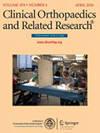Serum Amyloid A Is a Promising Tool for Screening Periprosthetic Joint Infection.
IF 4.2
2区 医学
Q1 ORTHOPEDICS
引用次数: 0
Abstract
BACKGROUND Although the modified Musculoskeletal Infection Society (MSIS) criteria are commonly used, the accurate and timely diagnosis of periprosthetic joint infection (PJI) remains challenging. Serum amyloid A, like C-reactive protein (CRP), is an acute-phase reactant and widely serves as a diagnostic tool for infectious diseases in adults and children. However, the role of serum amyloid A in diagnosing PJI has not been fully explored. QUESTIONS/PURPOSES (1) What were the sensitivity, specificity, positive predictive value (PPV), negative predictive value (NPV), and area under the curve (AUC) of serum amyloid A as a diagnostic test for PJI? (2) How did the diagnostic performance of serum amyloid A compare with that of other commonly used serum biomarkers? METHODS Between October 2020 and October 2023, three surgeons performed 137 revision THA or TKA procedures. All were considered potentially eligible, but we excluded 20% (28 of 137) because of reimplantation, missing blood biomarker data, and periprosthetic fracture, leaving 80% (109) for analysis in this retrospective study. Those were divided into two groups: those believed to have PJI (62) based on the modified 2018 MSIS criteria and those who did not meet 2018 MSIS criteria (non-PJI, n = 47). The PJI group comprised 56% males (median age 66 years) with 23 hips and 39 knees affected, while the non-PJI group included 17% males (median age 66 years) involving 25 hips and 22 knees. All 47 revisions in the non-PJI group were followed for at least 1 year to make sure that they were not false negatives. No patients were lost to follow-up during this period. Diagnostic accuracy was assessed using receiver operating characteristic (ROC) curve analysis. Sensitivity, specificity, PPV, NPV, and AUC were calculated for all four routine tests (serum amyloid A, CRP, erythrocyte sedimentation rate [ESR], and fibrinogen) to determine their diagnostic capacity for PJI. RESULTS For the diagnosis of PJI, with a cutoff value of 14 based on the Youden index, serum amyloid A had a sensitivity of 85% (95% confidence interval [CI] 74% to 93%), a specificity of 96% (95% CI 86% to 100%), a PPV of 96% (95% CI 87% to 99%), and an NPV of 83% (95% CI 73% to 90%). Using the optimal cutoffs for the AUC of the ROC as calculated by the Youden index for each test, serum amyloid A was more accurate than the ESR (0.96 versus 0.85; p = 0.005) and plasma fibrinogen (0.96 versus 0.84; p = 0.002) but no different from the CRP (0.96 versus 0.93; p = 0.17). CONCLUSION Our study established serum amyloid A as a promising high-accuracy biomarker for PJI screening, demonstrating superior performance to ESR and fibrinogen while being comparable with the diagnostic performance of CRP. This provides surgeons with a novel tool for screening suspected PJI, particularly when interpreting ambiguous CRP and ESR results or requiring rapid decision-making, as its combination of rapid kinetics, cost-efficiency, short turnaround time, and high specificity reduce diagnostic delays. While our findings demonstrate promise, this study did not stratify PJI subtypes. Future large-scale multicenter studies should validate these findings across diverse patient populations and establish subtype-specific diagnostic thresholds for acute and chronic PJI presentations. LEVEL OF EVIDENCE Level III, diagnostic study.血清淀粉样蛋白A是筛查假体周围关节感染的一种有前途的工具。
背景:虽然改良的肌肉骨骼感染学会(MSIS)标准被广泛使用,但准确和及时诊断假体周围关节感染(PJI)仍然具有挑战性。血清淀粉样蛋白A与c反应蛋白(CRP)一样,是一种急性期反应物,广泛用作成人和儿童感染性疾病的诊断工具。问题/目的(1)血清淀粉样蛋白A作为PJI诊断指标的敏感性、特异性、阳性预测值(PPV)、阴性预测值(NPV)和曲线下面积(AUC)如何?(2)与其他常用的血清生物标志物相比,血清淀粉样蛋白A的诊断性能如何?方法在2020年10月至2023年10月期间,3名外科医生进行了137例THA或TKA翻修手术。所有患者都被认为可能符合条件,但由于再植入术、血液生物标志物数据缺失和假体周围骨折,我们排除了20%(137例中的28例),留下80%(109例)的患者在本回顾性研究中进行分析。这些人被分为两组:根据修改后的2018年MSIS标准被认为有PJI的人(62人)和不符合2018年MSIS标准的人(非PJI, n = 47)。PJI组有56%的男性(中位年龄66岁)有23髋和39膝受影响,而非PJI组有17%的男性(中位年龄66岁)有25髋和22膝受影响。所有非pji组的47例修订至少随访1年,以确保他们没有假阴性。在此期间没有患者失去随访。采用受试者工作特征(ROC)曲线分析评估诊断准确性。计算所有四项常规检查(血清淀粉样蛋白A、CRP、红细胞沉降率[ESR]和纤维蛋白原)的敏感性、特异性、PPV、NPV和AUC,以确定它们对PJI的诊断能力。结果对于PJI的诊断,基于约登指数的截断值为14,血清淀粉样蛋白a的敏感性为85%(95%置信区间[CI] 74%至93%),特异性为96% (95% CI 86%至100%),PPV为96% (95% CI 87%至99%),NPV为83% (95% CI 73%至90%)。使用约登指数计算的ROC AUC的最佳截止点,血清淀粉样蛋白A比ESR更准确(0.96比0.85;P = 0.005)和血浆纤维蛋白原(0.96 vs 0.84;p = 0.002),但与CRP无差异(0.96 vs 0.93;P = 0.17)。结论本研究确定血清淀粉样蛋白A是一种有前景的高精度PJI筛查生物标志物,其诊断性能优于ESR和纤维蛋白原,且与CRP相当。这为外科医生提供了一种筛查疑似PJI的新工具,特别是在解释模棱两可的CRP和ESR结果或需要快速决策时,因为它结合了快速动力学、成本效益、短周转时间和高特异性,减少了诊断延误。虽然我们的发现显示了希望,但这项研究并没有对PJI亚型进行分层。未来的大规模多中心研究应该在不同的患者群体中验证这些发现,并建立急性和慢性PJI表现的亚型特异性诊断阈值。证据等级:诊断性研究III级。
本文章由计算机程序翻译,如有差异,请以英文原文为准。
求助全文
约1分钟内获得全文
求助全文
来源期刊
CiteScore
7.00
自引率
11.90%
发文量
722
审稿时长
2.5 months
期刊介绍:
Clinical Orthopaedics and Related Research® is a leading peer-reviewed journal devoted to the dissemination of new and important orthopaedic knowledge.
CORR® brings readers the latest clinical and basic research, along with columns, commentaries, and interviews with authors.

 求助内容:
求助内容: 应助结果提醒方式:
应助结果提醒方式:


